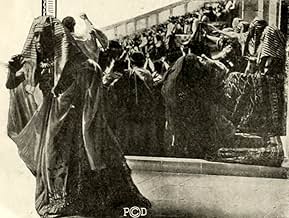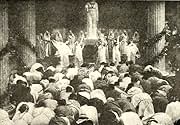IMDb RATING
6.1/10
648
YOUR RATING
Two love triangles intersect in ancient Pompei.Two love triangles intersect in ancient Pompei.Two love triangles intersect in ancient Pompei.
- Directors
- Writers
- All cast & crew
- Production, box office & more at IMDbPro
Featured review
This silent Italian melodrama may be a challenge for modern viewers, but it's a "must" for real fans of the silent era. Along with other early Italian epics now available in great DVD editions, such as "Cabiria" from 1914, these movies remind Americans that before World War I, European filmmakers were creative pioneers who stretched the medium and the imaginations of American directors. This film version of the "Pompeii" story was shot with static cameras and looks a bit like a broadly acted stage production transfered to film. But the production is elaborate, featuring stage sets as well as some location shooting. Just watching the images unfold in this twisted tale of love and jealousy on the eve of the disastrous eruption of Mt. Vesuvius can be fascinating as we peer back across the century at this 1913 release. To current sensibilities, the film does reflect some prejudices of its era, including the casting of an Egyptian priest as the mysterious, evil force in Pompeii -- an early example of a century-long demonization of Arab figures in movies. However, for viewers exploring early cinema, who are familiar mainly with slapstick comedies and D.W. Griffith, watching a pre-WWI Italian epic like this can be a fascinating experience.
Storyline
Did you know
- TriviaFor a while in the late summer and fall of 1913 there were two major Italian productions on this subject playing simultaneously in the US, this one produced by Ambrosio, and Jone ovvero gli ultimi giorni di Pompei (1913), produced by Pasquali.
- GoofsExtras are "killed" by falling pieces of a set during the explosion scene, then appear to either get back up or adjust themselves so that they won't be trampled by other extras.
- Alternate versionsKino International Corp. copyrighted a version in 2000 with a piano music score compiled and arranged by Beatrice Jona Affron and performed by Martha Koeneman. It was produced for video by Bret Wood and runs 88 minutes.
- SoundtracksGiselle
Written by Adolphe Adam (as Adam)
Arranged by Beatrice Jona Affron
Performed by Martha Koeneman
Excerpts in the 2000 alternate version score
Details
- Release date
- Country of origin
- Languages
- Also known as
- The Last Days of Pompeii
- Production company
- See more company credits at IMDbPro
- Runtime1 hour 28 minutes
- Color
- Sound mix
- Aspect ratio
- 1.33 : 1
Contribute to this page
Suggest an edit or add missing content

Top Gap
By what name was Les derniers jours de Pompei (1913) officially released in Canada in English?
Answer





















